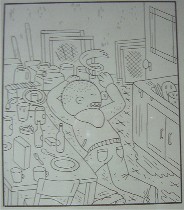 It’s good I didn’t read the student posts about the Comicology show at Slought Foundation before I took a look, or I might have forgotten to enjoy what was there. But enjoy it I did (so did Roberta; here’s her post) (image from Ron Rege Jr.’s “Where I Slept”).
It’s good I didn’t read the student posts about the Comicology show at Slought Foundation before I took a look, or I might have forgotten to enjoy what was there. But enjoy it I did (so did Roberta; here’s her post) (image from Ron Rege Jr.’s “Where I Slept”).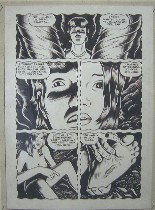 First of all, Charles Burns’ fabulous intense black and white drawings were sooo sexy–the antithesis of Archie comics. No saddle shoes, roadsters and Jughead here. Only the drawing style that calls back to Veronika’s hair lives on through Burns’ testosterone-driven “Black Hole,” which turns teenage angst and acne into a virus and turns wounds into vaginas, and whole multi-frame pages into vaginas. I didn’t care that the story was a little sketchy, and I assumed that the pages were not necessarily consecutive (image from Burn’s “Black Hole”).
First of all, Charles Burns’ fabulous intense black and white drawings were sooo sexy–the antithesis of Archie comics. No saddle shoes, roadsters and Jughead here. Only the drawing style that calls back to Veronika’s hair lives on through Burns’ testosterone-driven “Black Hole,” which turns teenage angst and acne into a virus and turns wounds into vaginas, and whole multi-frame pages into vaginas. I didn’t care that the story was a little sketchy, and I assumed that the pages were not necessarily consecutive (image from Burn’s “Black Hole”).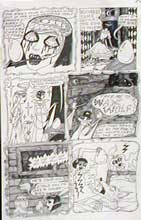 The Dame Darcy comics were, I thought, incredible, even though I was reading them in the dark because Slought turned me down when I asked if I could have some lights turned on. These were incredible feminist social commentary, dark and sarcastic, with a punk/Goth scratchy drawing style. Twisted fairy tales and stories of “girlfriend” betrayal hit on the twisted cultural expectations for women–passivity waiting for a phone call or a prince, weight and beauty issues, etc. Darcy is drawing in a male comix culture, and she’s the ultimate bad-girl, out-badding the boys and adding content no guy would ever handle (image from Dame Darcy’s “Meat Cake” comics).
The Dame Darcy comics were, I thought, incredible, even though I was reading them in the dark because Slought turned me down when I asked if I could have some lights turned on. These were incredible feminist social commentary, dark and sarcastic, with a punk/Goth scratchy drawing style. Twisted fairy tales and stories of “girlfriend” betrayal hit on the twisted cultural expectations for women–passivity waiting for a phone call or a prince, weight and beauty issues, etc. Darcy is drawing in a male comix culture, and she’s the ultimate bad-girl, out-badding the boys and adding content no guy would ever handle (image from Dame Darcy’s “Meat Cake” comics). Mark Bell creates an Escher-like world that’s a robotic or monster figure that moves and is the earth at the same time that it is a creature. It’s got the macrocosm-microcosm thing made visible, a sense of universe and my clubhouse in my little town. The wordplay and spaceplay are nothing short of fabulous.
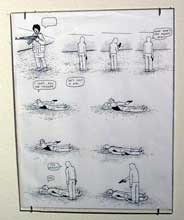 The existentialism /nihilism in Anders Nilsen with his space-filled collages and white-out takes comics in a direction that’s utterly unexpected. I am reminded of drawings by Justin Witte and by Robyn O’Neil, with their sense of the vast universe and dark happenings among the humans (image from Nilsen).
The existentialism /nihilism in Anders Nilsen with his space-filled collages and white-out takes comics in a direction that’s utterly unexpected. I am reminded of drawings by Justin Witte and by Robyn O’Neil, with their sense of the vast universe and dark happenings among the humans (image from Nilsen).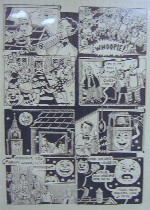 And Kim Deitch’s drawings take the Krazy Kat look and put it to dark purposes in multi-frame compositions. And Ron Rege Jr.’s strange thin-line drawings (see image top of post) have a sad-sack central character whose peregrinations take him all over the place so the drawings add up to an archive of our way of life (image, from Kim Deitch’s “Boulevard of Broken Dreams”).
And Kim Deitch’s drawings take the Krazy Kat look and put it to dark purposes in multi-frame compositions. And Ron Rege Jr.’s strange thin-line drawings (see image top of post) have a sad-sack central character whose peregrinations take him all over the place so the drawings add up to an archive of our way of life (image, from Kim Deitch’s “Boulevard of Broken Dreams”). While comics were not created for gallery walls, they are art that opens still another window on the culture and its paradigms. Putting the work in a gallery, as curators Judith Stein and her nephew Gabriel Greenberg have done, seems like a good thing to me. If you’re not looking at graphic novels you owe yourself the pleasure of checking out this work.









